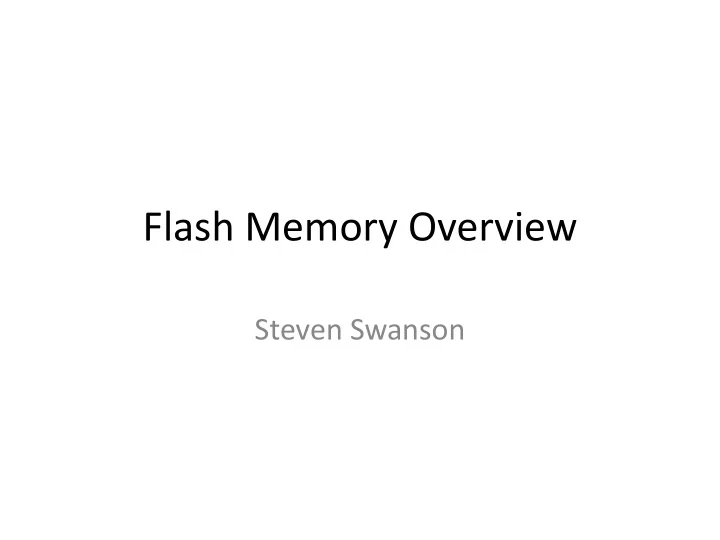

Flash Memory Overview Steven Swanson
Humanity processed 9 Zettabytes in 2008* Welcome to the Data Age! 2 *http://hmi.ucsd.edu
Solid State Memories • NAND flash – Ubiquitous, cheap – Sort of slow, idiosyncratic • Phase change, Spin torque MRAMs, etc. – On the horizon – DRAM-like speed – DRAM or flash-like density 3
1000000 100000 Bandwidth Relative to disk 5917x 2.4x/yr 10000 PCIe-Flash (2012) DDR Fast NVM (2016?) PCIe-PCM (2010) 1000 PCIe-PCM (2013?) 100 Hard Drives (2006) PCIe-Flash (2007) 10 7200x 2.4x/yr 1 1 10 100 1000 10000 100000 1000000 10000000 1/Latency Relative To Disk 4
Disk Density 1 Tb/sqare inch 5 5
Hard drive Cost • Today at newegg.com: $0.04 GB ($0.00004/MB) • 6 Desktop, 2 TB 6
Why Are Disks Slow? • They have moving parts :-( – The disk itself and the a head/arm • The head can only read at one spot. • High end disks spin at 15,000 RPM – Data is, on average, 1/2 an revolution away: 2ms – Power consumption limits spindle speed – Why not run it in a vacuum? • The head has to position itself over the right “ track ” – Currently about 150,000 tracks per inch. – Positioning must be accurate with about 175nm – Takes 3-13ms 7 7
Making Disks Faster • Caching – Everyone tries to cache disk accesses! – The OS – The disk controller – The disk itself. • Access scheduling – Reordering accesses can reduce both rotational and seek latencies 8 8
RAID! • Redundant Array of Independent (Inexpensive) Disks • If one disk is not fast enough, use many – Multiplicative increase in bandwidth – Multiplicative increase in Ops/Sec – Not much help for latency. • If one disk is not reliable enough, use many. – Replicate data across the disks – If one of the disks dies, use the replica data to continue running and re-populate a new drive. • Historical foot note: RAID was invented by one of the text book authors (Patterson) 9 9
RAID Levels • There are several ways of ganging together a bunch of disks to form a RAID array. They are called “ levels ” • Regardless of the RAID level, the array appears to the system as a sequence of disk blocks. • The levels differ in how the logical blocks are arranged physically and how the replication occurs. 10 1 0
RAID 0 • Double the bandwidth. • For an n-disk array, the n- th block lives on the n-th disk. • Worse for reliability – If one of your drives dies, all your data is corrupt-- you have lost every nth block. 11 1 1
RAID 1 • Mirror your data • 1/2 the capacity • But, you can tolerate a disk failure. • Double the bandwidth for reads • Same bandwidth for writes. 12 1 2
• Stripe your data across a bunch of disks • Use one bit to hold parity information – The number of 1 ’ s at corresponding locations across the drives is always even. • If you lose on drive, you can reconstruct it from the others. • Read and write all the disks in parallel. 13 1 3
The Flash Juggernaut
Flash is Fast! Hard Drives PCIe-Flash 2007 Lat.: 7.1ms 68us BW: 2.6MB/s 250MB/s 1x 104x 1x 96x • Random 4KB Reads from user space
Flash Operations 0V 1V Read Floating Gate 5V 0V 20V 20V Erase Program 0V 0V
Organizing Flash Cells into Chips
Organizing Flash Cells into Chips • ~16K blocks/chip • ~16-64Gbits/chip
Flash Operations Page: 0 1 2 3 4 n-4 n-3 n-2 n-1 n SLC: Single Level Cell Block 0 … Block 1 … == 1 bit Block 2 … MLC: Multi Level Cell … … … Block n … == 2 bits Erase Program Blocks Pages TLC: Triple Level Cell == 3 bits
Single-Level Cell Endurance: 100,000 Cycles Data retention: 10 years Read Latency: 25us Program Latency: 100-200us == 1 bit
Multi-Level Cell (2 bits) Endurance: 5000-10,000 Cycles Data retention: 3-10 years Read Latency: 25-37us Program Latency: 600-1800us == 2 bits
Triple-level Cell (3bits) Endurance: ~500-1000 Cycles Data retention: 3 years Read Time: 60-120us Program Time: 500-6500us == 3 bits
3D Nand • SLC, MLC, and TLC NAND cells are 4F 2 devices. – 1.33 – 4F 2 per bit • Higher densities require 3D designs – Samsung has demonstrated 24 layers – 2-4x density boost • http://bcove.me/xz2o1af5
Flash Failure Mechanisms • Program/Erase (PE) Wear – Permanent damaged to the gate oxide at each flash cell – Caused by high program/erase voltages – Damage causes charge to leak off the floating gate • Program disturb – Data corruption caused by interference from programming adjacent cells. – No permanent damage
Making Disks out Flash Chips Read Pages Write Pages Read Erase Blocks Write Hierarchical addresses Flat address space PE Wear No wear limitations
Writing Data SSD Maintain a map between “virtual” logical block addresses and “physical” flash locations.
Writing more data… When you overwrite data, it goes to a new location.
Flash Translation Layer (FTL) User • Logical Block Address Software Flash • Write pages in order • Erase/Write granularity FTL • Wears out FTL Flash • Logical Physical map • Wear leveling • Power cycle recovery
Centralized FTL State Map Write Point LBA Physical Page Address 101001011010001 010100100101011 0 Block 5 Page 7 101010110101001 2k Block 27 Page 0 111111111111111 4k Block 10 Page 2 111111111111111 111111111111111 Next Sequence Number: 12 Block Info Table Block Erased Erase Valid Page Sequence Bad Block Count Count Number Indicator 0 False 3 15 5 False 1 True 7 0 - False 2 False 0 4 9 False
Read Software 1. Read Data at LBA 2k 2. Map LBA Physical Page Address FTL 0 Block 5 Page 7 2k Block 27 Page 0 4k Block 10 Page 2 Flash 3. Flash Operation
Recommend
More recommend